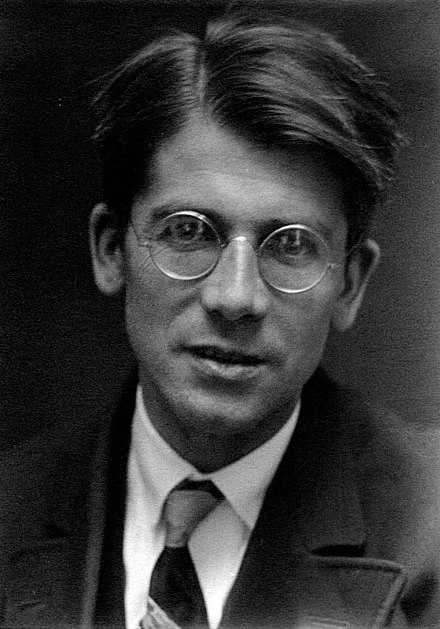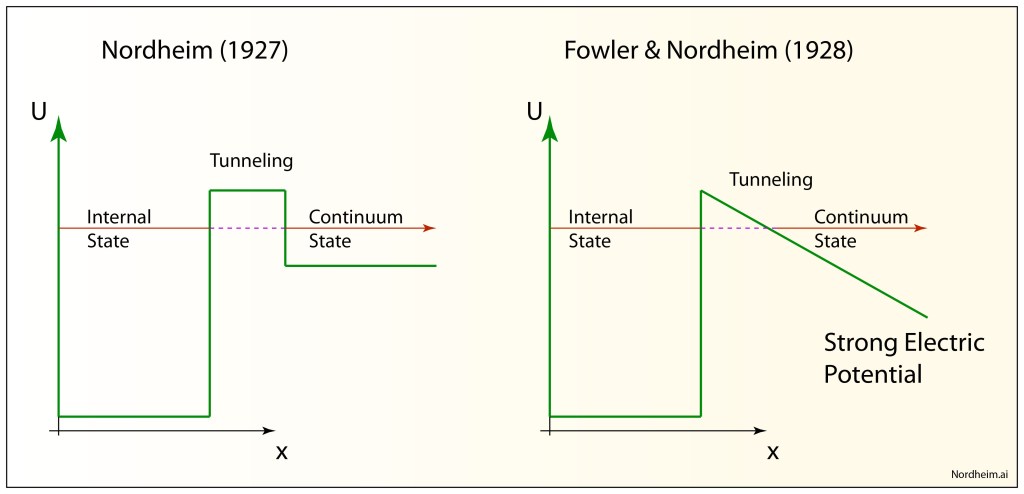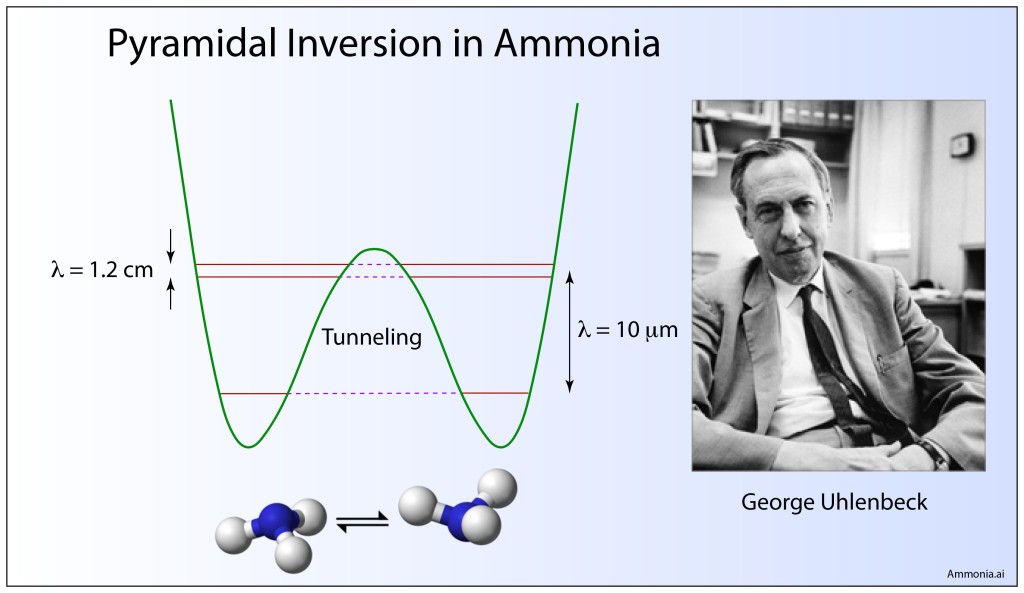Quantum physics is often called “weird” because it does things that are not allowed in classical physics and hence is viewed as non-intuitive or strange. Perhaps the two “weirdest” aspects of quantum physics are quantum entanglement and quantum tunneling. Entanglement allows a particle state to extend across wide expanses of space, while tunneling allows a particle to have negative kinetic energy. Neither of these effects has a classical analog.
Quantum entanglement arose out of the Bohr-Einstein debates at the Solvay Conferences in the 1920’s and 30’s, and it was the subject of a recent Nobel Prize in Physics (2022). The quantum tunneling story is just as old, but it was recognized much earlier by the Nobel Prize in 1972 when it was awarded to Brian Josephson, Ivar Giaever and Leo Esaki—each of whom was a graduate student when they discovered their respective effects and two of whom got their big idea while attending a lecture class.
Always go to class, you never know what you might miss, and the payoff is sometimes BIG
Ivar Giaever
Of the two effects, tunneling is the more common and the more useful in modern electronic devices (although entanglement is coming up fast with the advent of quantum information science). Here is a short history of quantum tunneling, told through a series of publications that advanced theory and experiments.
Double-Well Potential: Friedrich Hund (1927)
The first analysis of quantum tunneling was performed by Friedrich Hund (1896 – 1997), a German physicist who studied early in his career with Born in Göttingen and Bohr in Copenhagen. He published a series of papers in 1927 in Zeitschrift für Physik [1] that solved the newly-proposed Schrödinger equation for the case of the double well potential. He was particularly interested in the formation of symmetric and anti-symmetric states of the double well that contributed to the binding energy of atoms in molecules. He derived the first tunneling-frequency expression for a quantum superposition of the symmetric and anti-symmetric states

where f is the coherent oscillation frequency, V is the height of the potential and hν is the quantum energy of the isolated states when the atoms are far apart. The exponential dependence on the potential height V made the tunnel effect extremely sensitive to the details of the tunnel barrier.

Electron Emission: Lothar Nordheim and Ralph Fowler (1927 – 1928)
The first to consider quantum tunneling from a bound state to a continuum state was Lothar Nordheim (1899 – 1985), a German physicist who studied under David Hilbert and Max Born at Göttingen and worked with John von Neumann and Eugene Wigner and later with Hans Bethe. In 1927 he solved the problem of a particle in a well that is separated from continuum states by a thin finite barrier [2]. Using the new Schrödinger theory, he found transmission coefficients that were finite valued, caused by quantum tunneling of the particle through the barrier. Nordheim’s use of square potential wells and barriers are now, literally, textbook examples that every student of quantum mechanics solves. (For a quantum simulation of wavefunction tunneling through a square barrier see the companion Quantum Tunneling YouTube video.) Nordheim later escaped the growing nationalism and anti-semitism in Germany in the mid 1930’s to become a visiting professor of physics at Purdue University in the United States, moving to a permanent position at Duke University.

One of the giants of mathematical physics in the UK from the 1920s through the 1930’s was Ralph Fowler (1889 – 1944). Three of his doctoral students went on to win Nobel Prizes (Chandrasekhar, Dirac and Mott) and others came close (Bhabha, Hartree, Lennard-Jones). In 1928 Fowler worked with Nordheim on a more realistic version of Nordheim’s surface electron tunneling that could explain thermionic emission of electrons from metals under strong electric fields. The electric field modified Nordheim’s square potential barrier into a triangular barrier (which they treated using WKB theory) to obtain the tunneling rate [3]. This type of tunnel effect is now known as Fowler-Nordheim tunneling.
Nuclear Alpha Decay: George Gamow (1928)
George Gamov (1904 – 1968) is one of the icons of mid-twentieth-century physics. He was a substantial physicist who also had a solid sense of humor that allowed him to achieve a level of cultural popularity shared by a few of the larger-than-life physicists of his time, like Richard Feynman and Stephen Hawking. His popular books included One Two Three … Infinity as well as a favorite series of books under the rubric of Mr. Tompkins (Mr. Tompkins in Wonderland and Mr. Tompkins Explores the Atom, among others). He also wrote a history of the early years of quantum theory (Thirty Years that Shook Physics).
In 1928 Gamow was in Göttingen (the Mecca of early quantum theory) with Max Born when he realized that the radioactive decay of Uranium by alpha decay might be explained by quantum tunneling. It was known that nucleons were bound together by some unknown force in what would be an effective binding potential, but that charged alpha particles would also feel a strong electrostatic repulsive potential from a nucleus. Gamow combined these two potentials to create a potential landscape that was qualitatively similar to Nordheim’s original system of 1927, but with a potential barrier that was neither square nor triangular (like the Fowler-Nordheim situation).

Gamow was able to make an accurate approximation that allowed him to express the decay rate in terms of an exponential term

where Zα is the atomic charge of the alpha particle, Z is the nuclear charge of the Uranium decay product and v is the speed of the alpha particle detected in external measurements [4].
The very next day after Gamow submitted his paper, Ronald Gurney and Edward Condon of Princeton University submitted a paper [5] that solved the same problem using virtually the same approach … except missing Gamow’s surprisingly concise analytic expression for the decay rate.
Molecular Tunneling: George Uhlenbeck (1932)
Because tunneling rates depend inversely on the mass of the particle tunneling through the barrier, electrons are more likely to tunnel through potential barriers than atoms. However, hydrogen is a particularly small atom and is therefore the most amenable to experiencing tunneling.
The first example of atom tunneling is associated with hydrogen in the ammonia molecule NH3. The molecule has a pyramidal structure with the Nitrogen hovering above the plane defined by the three hydrogens. However, an equivalent configuration has the Nitrogen hanging below the hydrogen plane. The energies of these two configurations are the same, but the Nitrogen must tunnel from one side of the hydrogen plane to the other through a barrier. The presence of light-weight hydrogen that can “move out of the way” for the nitrogen makes this barrier very small (infrared energies). When the ammonia is excited into its first vibrational excited state, the molecular wavefunction tunnels through the barrier, splitting the excited level by an energy associated with a wavelength of 1.2 cm which is in the microwave. This tunnel splitting was the first microwave transition observed in spectroscopy and is used in ammonia masers.

One of the earliest papers [6] written on the tunneling of nitrogen in ammonia was published by George Uhlenbeck in 1932. George Uhlenbeck (1900 – 1988) was a Dutch-American theoretical physicist. He played a critical role, with Samuel Goudsmit, in establishing the spin of the electron in 1925. Both Uhlenbeck and Goudsmit were close associates of Paul Ehrenfest at Leiden in the Netherlands. Uhlenbeck is also famous for the Ornstein-Uhlenbeck process which is a generalization of Einstein’s theory of Brownian motion that can treat active transport such as intracellular transport in living cells.
Solid-State Electron Tunneling: Leo Esaki (1957)
Although the tunneling of electrons in molecular bonds and in the field emission from metals had been established early in the century, direct use of electron tunneling in solid state devices had remained elusive until Leo Esaki (1925 – ) observed electron tunneling in heavily doped Germanium and Silicon semiconductors. Esaki joined an early precursor of Sony electronics in 1956 and was supported to obtain a PhD from the University of Tokyo. In 1957 he was working with heavily-doped p-n junction diodes and discovered a phenomenon known as negative differential resistance where the current through an electronic device actually decreases as the voltage increases.
Because the junction thickness was only about 100 atoms, or about 10 nanometers, he suspected and then proved that the electronic current was tunneling quantum mechanically through the junction. The negative differential resistance was caused by a decrease in available states to the tunneling current as the voltage increased.

Esaki tunnel diodes were the fastest semiconductor devices of the time, and the negative differential resistance of the diode in an external circuit produced high-frequency oscillations. They were used in high-frequency communication systems. They were also radiation hard and hence ideal for the early communications satellites. Esaki was awarded the 1973 Nobel Prize in Physics jointly with Ivar Giaever and Brian Josephson.
Superconducting Tunneling: Ivar Giaever (1960)
Ivar Giaever (1929 – ) is a Norwegian-American physicist who had just joined the GE research lab in Schenectady New York in 1958 when he read about Esaki’s tunneling experiments. He was enrolled at that time as a graduate student in physics at Rensselaer Polytechnic Institute (RPI) where he was taking a course in solid state physics and learning about superconductivity. Superconductivity is carried by pairs of electrons known as Cooper pairs that spontaneously bind together with a binding energy that produced an “energy gap” in the electron energies of the metal, but no one had ever found a way to directly measure it. The Esaki experiment made him immediately think of the equivalent experiment in which Cooper pairs might tunnel between two superconductors (through a thin oxide layer) and yield a measurement of the energy gap. The idea actually came to him during the class lecture.
The experiments used a junction between aluminum and lead (Al—Al2O3—Pb). At first, the temperature of the system was adjusted so that Al remained a normal metal and Pb was superconducting, and Giaever observed a tunnel current with a threshold related to the gap in Pb. Then the temperature was lowered so that both Al and Pb were superconducting, and a peak in the tunnel current appeared at the voltage associated with the difference in the energy gaps (predicted by Harrison and Bardeen).

The Josephson Effect: Brian Josephson (1962)
In Giaever’s experiments, the external circuits had been designed to pick up “ordinary” tunnel currents in which individual electrons tunneled through the oxide rather than the Cooper pairs themselves. However, in 1962, Brian Josephson (1940 – ), a physics graduate student at Cambridge, was sitting in a lecture (just like Giaever) on solid state physics given by Phil Anderson (who was on sabbatical there from Bell Labs). During lecture he had the idea to calculate whether it was possible for the Cooper pairs themselves to tunnel through the oxide barrier. Building on theoretical work by Leo Falicov who was at the University of Chicago and later at Berkeley (years later I was lucky to have Leo as my PhD thesis advisor at Berkeley), Josephson found a surprising result that even when the voltage was zero, there would be a supercurrent that tunneled through the junction (now known as the DC Josephson Effect). Furthermore, once a voltage was applied, the supercurrent would oscillate (now known as the AC Josephson Effect). These were strange and non-intuitive results, so he showed Anderson his calculations to see what he thought. By this time Anderson had already been extremely impressed by Josephson (who would often come to the board after one of Anderson’s lectures to show where he had made a mistake). Anderson checked over the theory and agreed with Josephson’s conclusions. Bolstered by this reception, Josephson submitted the theoretical prediction for publication [9].
As soon as Anderson returned to Bell Labs after his sabbatical, he connected with John Rowell who was making tunnel junction experiments, and they revised the external circuit configuration to be most sensitive to the tunneling supercurrent, which they observed in short time and submitted a paper for publication. Since then, the Josephson Effect has become a standard element of ultra-sensitive magnetometers, measurement standards for charge and voltage, far-infrared detectors, and have been used to construct rudimentary qubits and quantum computers.
By David D. Nolte: Nov. 6, 2022
YouTube Video
YouTube Video of Quantum Tunneling Systems
References:
[1] F. Hund, Z. Phys. 40, 742 (1927). F. Hund, Z. Phys. 43, 805 (1927).
[2] L. Nordheim, Z. Phys. 46, 833 (1928).
[3] R. H. Fowler, L. Nordheim, Proc. R. Soc. London, Ser. A 119, 173 (1928).
[4] G. Gamow, Z. Phys. 51, 204 (1928).
[5] R. W. Gurney, E. U. Condon, Nature 122, 439 (1928). R. W. Gurney, E. U. Condon, Phys. Rev. 33, 127 (1929).
[6] Dennison, D. M. and G. E. Uhlenbeck. “The two-minima problem and the ammonia molecule.” Physical Review 41(3): 313-321. (1932)
[7] L. Esaki, New Phenomenon in Narrow Germanium Para-Normal-Junctions, Phys. Rev., 109, 603-604 (1958); L. Esaki, (1974). Long journey into tunneling, disintegration, Proc. of the Nature 123, IEEE, 62, 825.
[8] I. Giaever, Energy Gap in Superconductors Measured by Electron Tunneling, Phys. Rev. Letters, 5, 147-148 (1960); I. Giaever, Electron tunneling and superconductivity, Science, 183, 1253 (1974)
[9] B. D. Josephson, Phys. Lett. 1, 251 (1962); B.D. Josephson, The discovery of tunneling supercurrent, Science, 184, 527 (1974).
[10] P. W. Anderson, J. M. Rowell, Phys. Rev. Lett. 10, 230 (1963); Philip W. Anderson, How Josephson discovered his effect, Physics Today 23, 11, 23 (1970)
[11] Eugen Merzbacher, The Early History of Quantum Tunneling, Physics Today 55, 8, 44 (2002)
[12] Razavy, Mohsen. Quantum Theory Of Tunneling, World Scientific Publishing Company, 2003.


